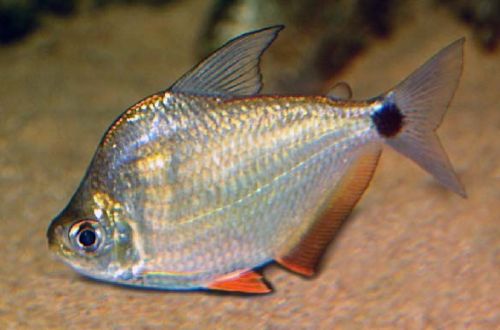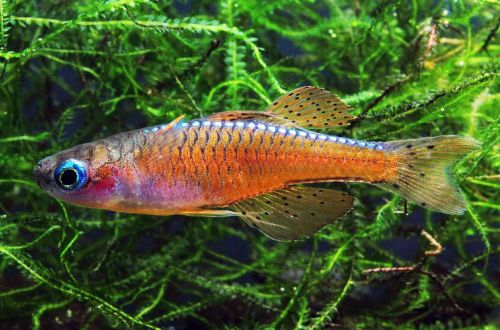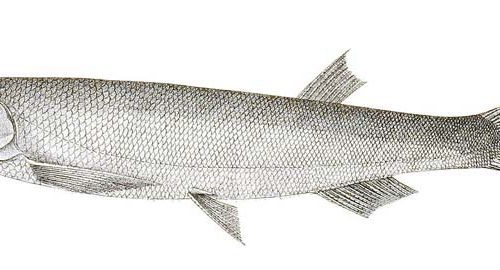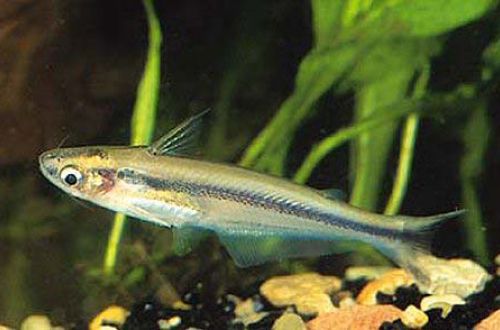
npib ntses
The coin fish, scientific name Ctenobrycon spilurus, belongs to the Characidae family. It comes from South America from the lower basin of the Orinoco River, located in Guyana, Suriname and French Guiana. Inhabits shallow parts of rivers with dense aquatic vegetation.

txheem
Hauj lwm
Adult individuals reach a length of about 8 cm. The fish has a high, but at the same time flat body from the sides, which, coupled with a silvery color, caused the word “coin” to appear in the name. A bright black dot is noticeable at the base of the tail, another one is located behind the gill cover, but is not so pronounced. The anal and ventral fins are reddish.
Sexual dimorphism is weakly expressed, males and females have few visible differences.
Cov ntaub ntawv luv luv:
- Qhov ntim ntawm thoob dej yug ntses - los ntawm 150 litres.
- Kub - 20-28 ° C
- pH tus nqi yog kwv yees li 7.0
- Dej hardness - txog li 20 dH
- Substrate hom - ib yam
- Teeb pom kev zoo - subdued los yog nruab nrab
- Cov dej tsis huv - tsis muaj
- Kev txav dej tsis muaj zog
- Qhov loj ntawm cov ntses yog hais txog 8 cm.
- Khoom noj - txhua yam khoom noj
- Temperament - kev thaj yeeb, nquag
- Nyob rau hauv ib pab pawg neeg ntawm 6-8 tus neeg
Kev tu thiab tu, kev npaj ntawm lub thoob dej yug ntses
The optimal size of the aquarium for a flock of 6-8 individuals starts from 150 liters. In the design, it is important to provide open areas for swimming and places for shelters in the form of thickets of plants. It is advisable to use species with hard foliage, as fish tend to damage the soft parts of plants. The presence of natural decor from snags and stones is welcome.
With long-term maintenance, it is necessary to ensure a stable hydrochemical composition of water in the acceptable range of pH and dH values and regularly maintain the aquarium (cleaning the soil, preventive maintenance of equipment, replacing water with fresh water, etc.)
Coin fish do not respond well to strong currents, the main source of which is usually the filter. When choosing a filtration system, you should give preference to models that do not cause excessive movement of water.
Khoom noj khoom haus
Omnivorous species. Will accept popular dry, frozen and live foods of the appropriate size. The composition of the food served should contain plant components.
Cwj Pwm thiab Compatibility
Active peaceful fish. They prefer to be in a group of 6-8 individuals. One by one they become overly shy. Compatible with other non-aggressive species of comparable size among tetras, small catfish, cyprinids (barbs, zebrafish, rabora) and others.
Kev yug me nyuam
In favorable conditions, spawning occurs regularly. With the onset of the breeding season, males arrange mating games. Spawning occurs in the upper layer of water among high thickets of plants. Fertilized eggs are left to themselves. Their only protection is the very thickets of plants. Parental care is absent. Adult fish do not care about laying and, on occasion, they will definitely eat their own eggs. In order to protect the offspring, the eggs are carefully transferred to a separate tank with identical water conditions.
The incubation period lasts 30-36 hours. For the first time in their lives, the fry feed on the remnants of the yolk pawn, and only a week later they begin to swim freely in search of food.
Feed with specialized powdered feed or suspensions.
Ntses kab mob
In a suitable habitat and in the absence of hostile aquarium neighbors, nothing threatens the health of the fish. In the event of the first signs of illness, it is necessary to check the hydrochemical composition of the water and the presence of dangerous concentrations of nitrogen cycle products. Perhaps the fish is stressed due to poor water quality.
For more information on symptoms and treatments, see the Aquarium Fish Diseases section.





